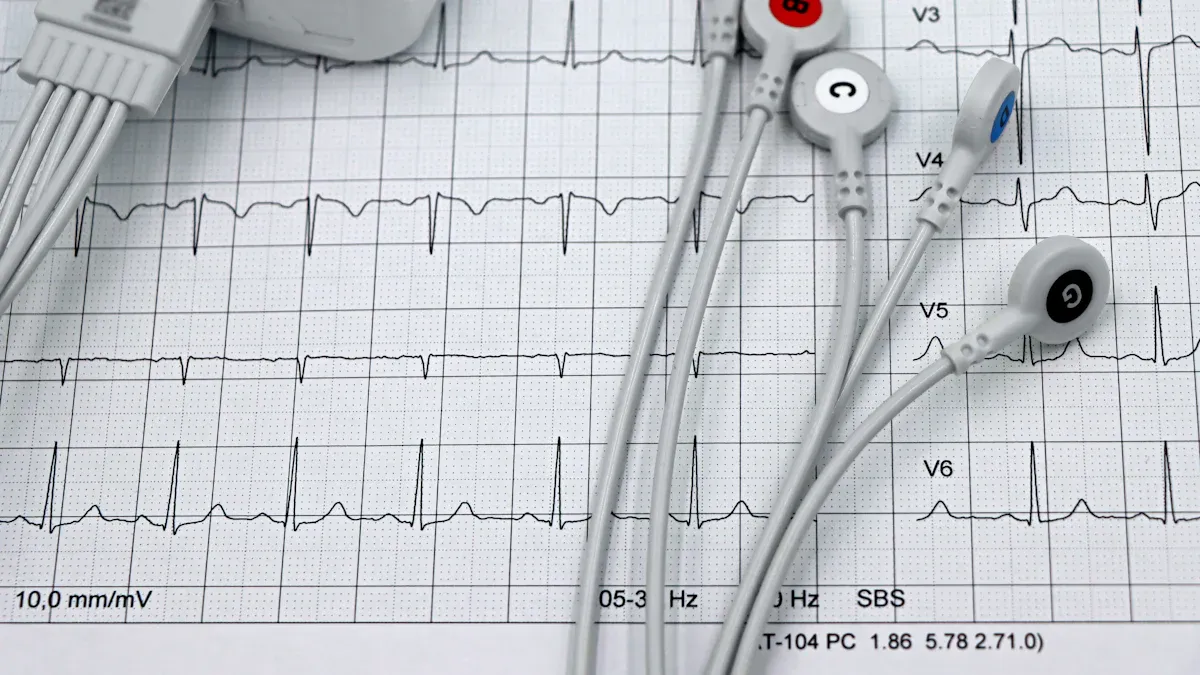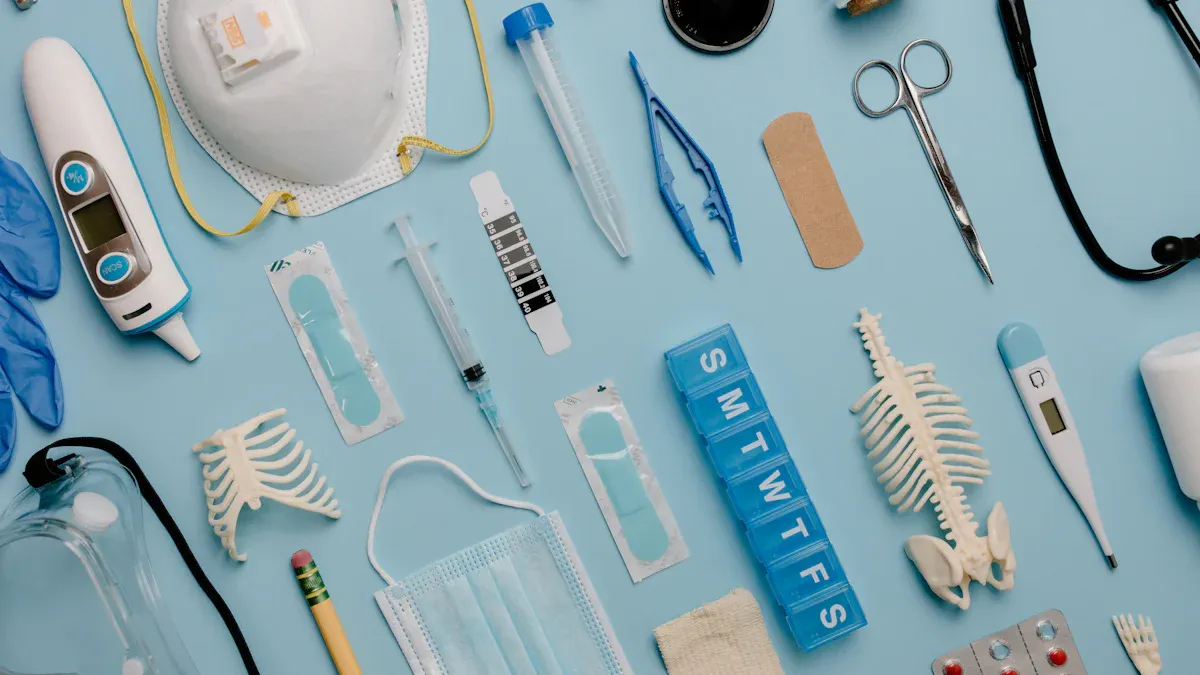Review of Nitinol Tubing in Cardiovascular Medical Devices

Nitinol tubing plays a crucial role in the applications of Nitinol tubing in medical devices. Its unique properties, such as shape memory and superelasticity, make it ideal for treatments related to the heart and bones. For instance, stents crafted from nitinol enhance blood flow and reduce the likelihood of blood vessels becoming blocked again. Additionally, guidewires and catheters benefit from its flexibility, allowing them to navigate complex pathways with ease, which minimizes tissue damage. Research indicates that nitinol is durable, contributing to the reliability of implants. These applications of Nitinol tubing in medical devices highlight its significant impact on improving patient outcomes and overall health.
Key Takeaways
Nitinol tubing is tough and bends easily, perfect for medical tools like stents and guidewires.
It can remember its shape and go back to it, helping tools work better in changing conditions.
Nitinol is safe for the body and does not rust, making it good for long-term use.
Its flexibility helps with small surgeries, needing tiny cuts and faster healing.
Scientists are working to make nitinol cheaper and use it in more medical areas.
What is Nitinol Tubing?
Overview of Nitinol as a Material
Nitinol is a mix of nickel and titanium metals. Its name comes from "Nickel," "Titanium," and the Naval Ordnance Laboratory (NOL), where it was discovered. Nitinol is popular in medical tools because of its special traits like shape-memory and superelasticity. These features make it useful for heart and bone treatments.
Nitinol is also used outside of healthcare. It helps in making parts for airplanes, gadgets, and even bendable eyeglasses. But its biggest impact is in medicine, where it has changed how devices are made. Its flexibility and strength make it very reliable.
Key Properties: Shape Memory and Superelasticity
Nitinol has two main features: shape-memory and superelasticity. Shape-memory means it can go back to its original shape after being bent when heated. This is great for stents that open blocked arteries. Superelasticity lets nitinol stretch and bend without breaking. For example, nitinol guidewires can twist through tricky blood vessels and still work well.
Studies show nitinol can handle up to 6% strain, making it strong for long-term use. Temperature affects how it works. When cold, it stays flexible in its martensitic phase. When heated, it becomes stiff and returns to its original shape in the austenitic phase. This makes it a key material for shape-memory alloys.
Biocompatibility and Corrosion Resistance
For medical use, materials must be safe for the body. Nitinol is biocompatible, meaning it works well inside humans. It also resists rust, which makes it good for long-term implants. Research shows nitinol stays strong even in body fluids, lowering risks of problems.
Studies by Rahimipour et al. and Ryhänen et al. prove nitinol’s safety and rust resistance in heart-related uses. These qualities make it perfect for devices like heart valve frames and plugs. Companies like AccuPath use nitinol to make strong, safe tubing for less invasive surgeries.
Applications of Nitinol Tubing in Cardiovascular Medical Devices

Stents: Flexible and Long-Lasting
Nitinol stents have changed how blood vessel problems are treated. These small tubes keep blood vessels open and improve blood flow. Nitinol's special traits, like bending and shape memory, help stents adjust to moving blood vessels. This makes them work well even in tough conditions.
Nitinol stents are also very strong. They handle the constant movement and pressure inside blood vessels. For example:
Nitinol lasts longer, making it great for active areas.
It bends back to its shape after being squished, staying useful.
Nitinol is safe for the body, lowering health risks.
Benefit | How It Helps Cardiovascular Devices |
|---|---|
Flexibility | Stents adjust to moving blood vessels, improving performance. |
Durability | Strong material ensures stents last a long time. |
Biocompatibility | Safe for the body, reducing bad reactions. |
Guidewires: Better Control and Movement
Guidewires are tools that help doctors reach tricky blood vessels. Nitinol makes them more flexible and precise. Its bending ability lets guidewires twist and turn without breaking. This helps them move through tight or curvy blood vessels easily.
Nitinol's shape memory helps guidewires return to their original form. This gives doctors better control during procedures. Studies show nitinol guidewires are more accurate, making them a top choice for medical tools.
Feature | How It Helps Guidewires |
|---|---|
Superelasticity | Makes guidewires bend and move through hard pathways. |
Shape Memory | Keeps guidewires in their original shape for better control. |
Heart Valve Frames: Strong and Adaptable
Nitinol heart valve frames support replacement heart valves. These frames must handle constant heart movement and pressure. Nitinol's strength helps them stay in good shape for a long time.
Nitinol's shape memory lets frames be squeezed for easy placement. Once inside, they expand to fit perfectly. This makes nitinol frames great for heart valves, helping patients recover faster and feel better.
Occlusion Devices: Helping with Blood Vessel Treatments
Occlusion devices are important tools for fixing blood vessel problems. They block or close unusual blood flow in vessels. This helps treat issues like aneurysms or abnormal connections between veins and arteries. These devices often use nitinol tubing because it is strong and flexible.
Nitinol's special traits, like shape memory and superelasticity, make these devices work well. They can shrink to fit into small blood vessels during insertion. After placement, they expand to block the problem area securely. This flexibility helps prevent complications and ensures the device stays in place.
Why is nitinol used for these devices? It is safe for the body and doesn’t rust, making it great for long-term use. In treatments like embolization therapy, nitinol occlusion devices stop blood flow to tumors or abnormal growths. This improves patient health and recovery.
These devices also make surgeries less invasive. Doctors can treat blood vessel problems without opening the body. This means faster healing and fewer infections. Because of this, occlusion devices are now key tools for safer and better treatments.
Tip: Keep an eye on how nitinol tubing is changing medical care. Its amazing features are improving treatments and making surgeries easier.
Applications of Nitinol Tubing in Orthopedic Devices
Orthopedic Implants: Helping Bones Heal
Nitinol tubing has changed how orthopedic implants work. Its special traits, like shape memory and superelasticity, help implants move with the body. This makes them less stressful on bones and tissues, helping them heal faster.
Nitinol is safe for the body, so it rarely causes problems. It also doesn’t rust, making it great for long-term use. Whether in joint replacements or bone plates, nitinol tubing makes implants stronger and more reliable.
Fixation Devices: Keeping Bones Steady
Fixation devices made with nitinol tubing are both strong and flexible. They hold broken bones in place while they heal. Nitinol’s superelasticity helps these devices stay in shape under pressure, giving steady support during recovery.
Studies show nitinol lasts longer than other materials. Its shape memory lets devices adjust to body movements, lowering risks of issues. Fixation devices with nitinol tubing work well and help patients heal better.
Spinal Devices: Supporting the Spine and Allowing Movement
Spinal devices use nitinol tubing to support the spine while letting it move. Nitinol’s flexibility helps these devices move with the body, making them more comfortable.
The shape memory of nitinol tubing ensures spinal devices fit perfectly and keep their shape. This is important for surgeries like spinal fusion or scoliosis correction. Nitinol is strong, safe, and lasts a long time, making it great for spinal implants.
Note: Nitinol tubing is changing orthopedic devices by being flexible, strong, and safe. Its special features help patients recover faster and feel better.
Advantages of Nitinol Tubing in Medical Devices

Durability and Longevity
Medical devices need to last a long time. Nitinol tubing is very strong and doesn’t break easily. It can handle repeated stress without wearing out. This makes it perfect for implants like stents, which face constant movement and pressure.
Nitinol's ability to bounce back to its shape adds to its durability. This is important for surgeries that don’t require big cuts. It can also stretch up to 6% without damage, making it dependable for years.
Studies show nitinol lasts longer than other materials.
It stays strong even after being bent many times.
Its shape memory helps it work well in active areas.
Flexibility and Adaptability
Nitinol tubing is very flexible, which helps it work with the body’s movements. This flexibility prevents damage to nearby tissues. For example, guidewires made of nitinol can move through tight spaces in the body easily.
Tests prove nitinol can be used again and again without problems. Whether it’s a stent fitting into a blood vessel or a spinal device moving with the body, nitinol tubing ensures comfort and accuracy.
Its flexibility lowers risks during medical procedures.
It adjusts well to different body movements.
Long-term tests show it keeps working over time.
Biocompatibility and Patient Safety
Safety is very important for medical devices. Nitinol tubing is safe for the body and doesn’t cause bad reactions. It also doesn’t rust, even when in contact with body fluids, making it great for implants that stay inside for a long time.
Because it’s safe and doesn’t corrode, nitinol tubing is trusted for heart and bone devices. Patients have fewer problems and better results because the material stays strong and reliable.
Tip: The special features of nitinol tubing make devices safer and better for patients, changing how medical tools are made today.
Minimally Invasive Applications
Nitinol tubing has changed how doctors do less invasive surgeries. Its special traits, like bending easily and shape memory, help tools move through your body gently. This means smaller cuts, quicker healing, and less discomfort for you.
One big use of nitinol tubing is in catheters. These thin tubes can travel through blood vessels to give treatments or run tests. Nitinol’s superelasticity lets catheters bend and twist without breaking. This helps them move through tricky paths safely and makes procedures more successful.
Another use is in endoscopic tools. These tools are used for surgeries or checks inside your body. Nitinol tubing helps them reach tight spots while staying strong. This makes surgeries like removing gallbladders or taking tissue samples easier and less painful.
Did you know? Nitinol tubing is also in embolization coils. These tiny devices stop unusual blood flow, like in aneurysms, without needing big surgeries. They expand to fit blood vessels, making treatments work better.
Benefits of Nitinol in Minimally Invasive Procedures | How It Helps You |
|---|---|
Flexibility | Protects tissues during surgeries. |
Shape Memory | Makes devices fit perfectly in place. |
Biocompatibility | Lowers risks of bad reactions. |
Nitinol tubing has made advanced tools possible. It helps doctors treat hard conditions with more accuracy while keeping you safe and comfortable.
Challenges and Future Directions for Nitinol Tubing
Manufacturing and Cost Challenges
Making nitinol tubing for medical use is not easy. The prices of nickel and titanium, its main materials, often change. This makes production more expensive. Only a few companies have the tools to make nitinol tubing with high accuracy. This limited supply raises costs even more.
Ensuring quality is also hard. Medical devices must meet strict rules, but making them perfect often leads to many failures during production. Shipping nitinol tubing adds to the cost too. It needs special care because it reacts to temperature changes, which makes transport more expensive.
Other problems include unstable regions and fewer skilled workers. Many materials for nitinol come from risky areas, causing supply issues. At the same time, there aren’t enough trained workers to increase production.
Challenge | Description |
|---|---|
Raw Material Volatility | Nickel and titanium prices change, raising production costs. |
Precision Manufacturing | Few companies can make nitinol tubing with needed accuracy. |
Quality Control Barriers | Strict rules lead to high failure rates and higher costs. |
Logistical Challenges | Temperature sensitivity makes shipping harder and costlier. |
Geopolitical Risks | Materials from unstable areas disrupt the supply chain. |
Skilled Labor Shortages | Not enough trained workers to meet growing demand. |
Limitations in Specific Applications
While nitinol tubing works well in many areas, it has limits. Some devices need to be stiff, but nitinol's flexibility may not work for them. For example, in some surgeries, nitinol tubing might not provide enough stiffness.
Its temperature sensitivity is another issue. Nitinol needs specific temperatures to work properly. This can be a problem in places where controlling temperature is hard. Also, its high cost makes it less available in some healthcare systems, limiting its use.
Innovations in Nitinol Tubing Technology
Even with these problems, scientists are finding solutions. New ways of making nitinol tubing are improving its quality and production. These methods help control its properties, making it stronger and more flexible. This makes it better for medical devices.
Researchers are also working to lower costs. By improving processes and finding new material sources, they aim to make nitinol tubing cheaper. This could help more patients benefit from it.
Nitinol's ability to keep its shape and work after repeated use is still a big focus. These improvements make sure devices last longer and work better, helping patients recover faster.
Note: As technology improves, nitinol tubing will likely become even more important in medical care.
Potential for Broader Medical Applications
Nitinol tubing could change many areas of medicine. Its special traits, like shape memory and superelasticity, make it useful for creating new medical tools. Soon, nitinol might be used in fields like brain care, stomach health, and cancer treatment.
In brain treatments, nitinol could help make better tools. Its ability to return to its shape after bending is helpful for fixing brain aneurysms or damaged nerves. Nitinol's flexibility lets it move through the nervous system safely. This could make treating brain problems easier and safer.
For stomach health, nitinol tubing could improve endoscopic tools. These tools need to bend and twist inside the digestive system. Nitinol's superelasticity helps them handle these movements without breaking. This makes surgeries like removing growths or fixing tears less painful and more accurate.
In cancer care, nitinol could be used in special implants. These implants can deliver medicine directly to tumors. Nitinol’s safety for the body makes it great for long-term use. This could lower side effects and make treatments work better.
Why Nitinol Tubing is Special:
Shape memory keeps devices working well over time.
Superelasticity helps tools fit into tricky body areas.
Biocompatibility ensures it’s safe for long-term use.
Nitinol tubing has a bright future in medicine. Its safety and flexibility allow it to be used in many ways, helping patients in different medical fields. As studies continue, nitinol tubing may lead to even better medical tools and treatments.
Nitinol tubing has changed how heart and bone devices are made. It is very flexible and strong, making it perfect for medical tools. Its shape memory and superelasticity help create smart tools like stents and guidewires. These tools are designed to fit different medical needs. They make treatments safer and help patients heal faster, especially in small surgeries. As nitinol tubing improves, it will lead to better medical tools and care in many areas.
Key Insight: Nitinol tubing’s special features are key to modern medical progress.
FAQ
Why is nitinol tubing special for medical tools?
Nitinol tubing is unique because it remembers its shape and bends easily. These features help it move with the body while still working well. It is safe for long-term use, making it great for advanced medical tools.
Can nitinol tubing be used in every surgery?
Nitinol tubing is best for small surgeries and flexible tools. But it might not work for surgeries needing stiff materials. Talk to your doctor to see if it’s right for your treatment.
How does nitinol tubing help patients?
Nitinol tubing helps patients by making surgeries smaller and healing faster. It also lowers risks of problems and works well for a long time. This leads to better results for patients.
Is nitinol tubing safe for implants that stay in the body?
Yes, nitinol tubing is safe for implants that stay inside. It doesn’t rust and is gentle on the body. This makes it a trusted choice for tools like stents and heart valve frames.
What makes making nitinol tubing hard?
Making nitinol tubing is costly because materials are expensive and need careful work. Strict rules and keeping it at the right temperature during shipping also make it harder to produce.
See Also
Nitinol Tubing's Impact on Healthcare Device Innovations
The Transformative Power of Nitinol Tubing in Medicine
The Manufacturing Process of Nitinol Tubing for Medicine

